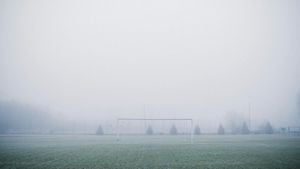Ukrainian refugees have been finding new homes and adapting to their new surroundings, showcasing resilience and community support amid the chaos of war. With the Russian invasion prompting millions to flee their homes, many have found refuge across Europe, particularly in countries like Latvia, where efforts have been made to help them settle and integrate.
Among these individuals is Kateryna Gorodnycha, who fled from Kyiv and has since transitioned from living with sponsors to finding her own temporary housing. She found solace in temporary cabins established for displaced individuals, describing them as her first home since leaving Ukraine. “I really love it. It’s our first home in Wales,” she shared, noting the joy of having her own space for her and her son. Yet, this positive sentiment about new living arrangements doesn’t resonate universally, as some local residents have raised concerns about the two-storey temporary housing units, claiming they have become eyesores.
Balancing the need for wellbeing and stability for both refugees and local residents has been challenging. Opposition voices like retired engineer Steve McGranaghan expressed discontent about the lack of consultation surrounding the development of these emergency shelters. He describes the structures as unattractive, feeling there could have been more consideration for local aesthetics and community input. Such sentiments echo throughout conversations about the refugee crisis: how can communities balance compassion and practicality, especially when there are competing needs for resources?
Despite the mixed feelings about housing arrangements, it’s clear the urgency of the situation calls for swift actions over lengthy planning processes. The local council emphasized the pressing need for housing as they strive to accommodate those who have been uprooted from their homes. “There has been unprecedented levels of extreme housing need,” they stated, echoing the sentiment of many municipalities facing similar challenges.
Across the Baltic states, over 50,000 Ukrainian refugees have found homes since the start of the conflict. Many of them are professionals, including healthcare workers, who have seamlessly transitioned their skills to their host countries. Doctor Irina Nikolaeva, who had to navigate the complex process of validating her medical credentials, expressed deep gratitude for the new opportunities but also highlighted the personal challenges of leaving her home behind. “Every day I thought the conflict would end soon and I would return home. But I decided to live my life,” she said, reinforcing the emotional toll displacement takes on individuals and families.
Employers have responded positively, recognizing the expertise these refugees bring. At the Bolderaja Medical Center, where Doctor Nikolaeva works, staff members acknowledged the quality and preparedness of the Ukrainian specialists, steering past initial apprehensions about differences between medical education systems.
The need for transitional housing and community support initiatives has spotlighted stories from both refugees and host communities. Events like benefit gatherings organized by churches, such as the one held at St. Luke's Episcopal Church, are fostering community bonds and raising funding for rehabilitation efforts for Ukrainian veterans. These initiatives not only provide financial assistance but also create opportunities for education on the plight of veterans and war survivors, emphasizing the interconnectedness of global communities.
Fundraising events, music, crafts, and food festivals celebrate Ukrainian culture and keep awareness alive among residents. Parishioners and volunteers, like Khrystyna Vozniak, who has just returned from Ukraine, share firsthand experiences to help bridge the knowledge gap and cultivate empathy among the local population. She stated, “I know it’s Veterans Day soon here, and I think us helping our veterans kind of relates the topic to the American people.” This sentiment resonates deeply, as communities rally around similar themes of remembrance and assistance.
The complexity of the refugee situation is ever-present, with councils and volunteers working tirelessly through various forms of housing solutions to create welcoming environments. These collaborative efforts pave the pathway for families hoping to rebuild their lives against the backdrop of uncertainty and loss.
Residences like temporary shelters offer more than just roofs over heads—they represent newfound hope, the ability to start again, and access to services ranging from healthcare to educational programs. This stable environment fosters resilience, allowing families to nurture their bonds and plan for the future.
It remains imperative to listen to both the voices of displaced individuals and the host communities. Constructive dialogue can help alleviate tensions and find common ground, enriching the neighborhoods where these shelters are established.
Through education, empathy, and shared experiences, refugees and local residents can learn to navigate this new chapter together, turning challenges of adaptation and acceptance of cultural diversity not only to survival but to striving communities rich with shared stories.
Overall, the Ukrainian refugee crisis reminds us of the strength of the human spirit, the importance of community solidarity, and the necessity of kindness amid adversity. The bonds formed between refugees and locals tell powerful stories of courage and hope, echoing the sentiment, “We are all one community.” The learning process, though challenging at times, leads to mutual growth and healing through shared experiences.



